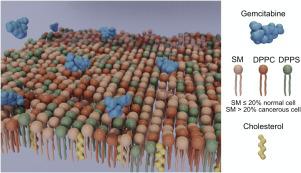Colloids and Surfaces B: Biointerfaces ( IF 5.4 ) Pub Date : 2020-09-21 , DOI: 10.1016/j.colsurfb.2020.111357 Elsa M Materon 1 , Gustavo F Nascimento 2 , Flavio M Shimizu 2 , Amanda S Câmara 2 , Bianca Sandrino 2 , Ronaldo C Faria 3 , Osvaldo N Oliveira 2

|
The fight against drug resistance in chemotherapy requires a molecular-level understanding of the drug interaction with cell membranes, which today is feasible with membrane models. In this study, we report on the interaction of gemcitabine (GEM), a pyrimidine nucleoside antimetabolite used to treat pancreatic cancer, with Langmuir films that mimic healthy and cancerous cell membranes. The cell membrane models were made with eight compositions of a quaternary mixture containing 1,2-dipalmitoyl-sn-glycerol-3-phosphocholine (DPPC), 1,2-dipalmitoyl-sn-glycero-3-phosphoserine (DPPS), sphingomyelin (SM), and cholesterol (CHOL). The relative concentration of SM was increased so that four of these compositions represented cancerous cells. GEM was found to increase the mean molecular area, also increasing their surface elasticity, with stronger interactions being observed for membranes corresponding to cancerous cells. More specifically, GEM penetrated deepest in the membrane with the highest SM concentration (40 mol%), as inferred from polarization-modulated infrared reflection absorption spectroscopy (PM-IRRAS). This finding was confirmed with molecular dynamics simulations that also indicated how GEM approaches the membrane, which could be useful for guiding the design of drug delivery systems. The experimental and simulation results are consistent with the preferential attachment of GEM onto cancerous cells and highlight the role of SM on drug-cell interactions.
中文翻译:

鞘磷脂在抗癌药物盐酸吉西他滨与细胞膜相互作用中的作用
在化学疗法中与耐药性作斗争需要在分子水平上了解药物与细胞膜的相互作用,这在今天的膜模型中是可行的。在这项研究中,我们报告了吉西他滨(GEM)(一种用于治疗胰腺癌的嘧啶核苷抗代谢药)与模仿健康和癌细胞膜的Langmuir膜之间的相互作用。细胞膜模型是由包含1,2-二棕榈酰基-sn-甘油-3-磷酸胆碱(DPPC),1,2-二棕榈酰基-sn-甘油-3-磷酸丝氨酸(DPPS),鞘磷脂( SM)和胆固醇(CHOL)。SM的相对浓度增加,使得这些组合物中的四个代表癌细胞。发现GEM可以增加平均分子面积,也可以提高其表面弹性,在与癌细胞对应的膜上观察到更强的相互作用。更具体地,如通过偏振调制红外反射吸收光谱法(PM-IRRAS)所推断的,GEM以最高的SM浓度(40mol%)以最深的膜渗透。分子动力学模拟证实了这一发现,该模拟还表明了GEM如何接近膜,这可能对指导药物输送系统的设计很有用。实验和模拟结果与GEM在癌细胞上的优先附着相一致,并突出了SM在药物-细胞相互作用中的作用。从偏振调制红外反射吸收光谱法(PM-IRRAS)推断。分子动力学模拟证实了这一发现,该分子动力学模拟还表明GEM如何接近膜,这对指导药物输送系统的设计很有用。实验和模拟结果与GEM在癌细胞上的优先附着相一致,并突出了SM在药物-细胞相互作用中的作用。从偏振调制红外反射吸收光谱法(PM-IRRAS)推断。分子动力学模拟证实了这一发现,该分子动力学模拟还表明GEM如何接近膜,这对指导药物输送系统的设计很有用。实验和模拟结果与GEM在癌细胞上的优先附着相一致,并突出了SM在药物-细胞相互作用中的作用。











































 京公网安备 11010802027423号
京公网安备 11010802027423号